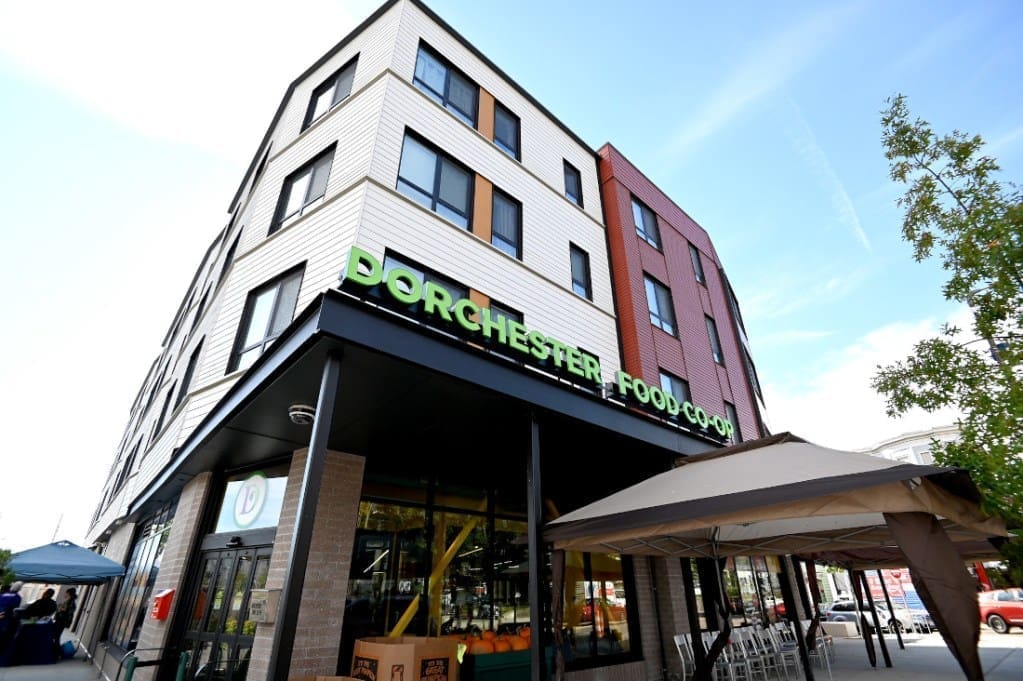Recently updated on October 5th, 2024 at 11:44 am
An 81 kilowatt project on the roof of the Dorchester Food Co-op will test a community ownership model, and new federal climate policies could help make it scalable.
Ok, this is an amazing idea! I began reading the article thinking it was about a local grocery store investing in solar energy and I thought, “That’s great! Start by introducing renewable energy to smaller communities by having local businesses act as “role models” of sorts. I had my tangent planned out where I’d talk about people in rural areas being most skeptical of climate change and renewable energy because of politicians and media that lie about it for money from fossil fuel companies (I went on a similar rant a few days ago). By having local businesses use it, more people might ask questions of the owners and learn enough to come around to the idea.
Well, to my surprise, what the article is actually referring to is even better! Have disadvantaged and low-income communities come together and invest in the cost of solar panel installation on a sunny location, like the rooftop of a tall building, in exchange for getting to use some of the electricity that is generated. What an awesome way to empower and unite community members! Everyone that invests in the up front cost of installation gets cheaper electricity while the old-fashioned idea of community members working together to improve their environment will get people out meeting each other—I can’t go on because my mind is racing faster than my fingers can type!
I don’t have to tell you all of the different ways that this could change so many things for the better. Not even including the benefit to the environment! Wow, I hope you guys feel as optimistic and excited as I do after learning about this group in Boston. I can’t believe I haven’t thought about it before (to be honest, my pessimism when it comes to governments doing good for the citizens probably would have discouraged me trying…thinking that fossil fuel companies or corrupt politicians in D.C. would somehow stop it).
Don’t let me be a Debbie Downer! Read more about it and share it with any of your friends with the time and ambition to start something like this in your area. The article is republished under a Creative Commons license from Energy News Network with reporting by Sarah Shemkus.
A group of energy equity advocates in Boston is launching a community solar cooperative they say could be a scalable model for both reducing carbon emissions and building wealth in disadvantaged communities.
The Boston Community Solar Cooperative is in the pre-development stage of an 81 kilowatt solar project on the roof of the Dorchester Food Co-op, in one of the city’s lowest-income neighborhoods. Residents will be able to buy or earn ownership stakes in the project, which will be governed by a board of community stakeholders. The food store will buy the power at a discounted rate and the revenue created will be shared among this group of owners.
When the Dorchester project is up and running, the coalition plans to replicate the model in other neighborhoods around Boston, as well as share details and lessons more widely so other communities can create their own co-ops.
“The idea is that the majority of the ownership for the Dorchester project will be owned by Dorchester community members,” said Gregory King, a co-founder of the cooperative and interim president of the board. “It’s about a community empowerment movement.”
The promise of community solar
Community solar, in which subscribers or co-owners pay for a share of the power generated, has been around for close to 20 years. Though it took about a decade to catch on, adoption began to pick up in the mid-2010s, and, today, some seven gigawatts of community solar capacity has been installed nationwide, up from just one gigawatt in 2018. Massachusetts is home to 882 megawatts.
From the beginning, advocates saw the potential in community solar to help bring the benefits of renewable energy to low-income and other historically disadvantaged communities. The approach allows anyone to buy clean energy, usually at a lower price than utility supply, without needing a sunny rooftop of their own or thousands to invest upfront.
“If you’re a renter, actually having your own solar array is almost impossible,” said Kendra Beaver, climate justice coordinator at the Fairmont Indigo CDC Collaborative in Boston and a co-founder of the cooperative. “For folks who do own their homes, there’s still a huge financial investment you have to make to put solar panels on your home.”
So far, though, the promise of using community solar to help narrow the wealth gap has not been realized: In 2022, just 2% of community solar customers were low-income, according to a report produced by Wood Mackenzie in collaboration with the Coalition for Community Solar Access. The trend is moving in the right direction, however. By the second half of 2023, low-income households made up 10% of community solar customers. And provisions of the 2022 federal Inflation Reduction Act (IRA) are likely to expand opportunities for low-income consumers even further.
“Community solar is a really great tool for energy equity and environmental justice. But our very first wave of community solar programs and projects served a more general market, with a larger portion of middle-income to upper-income customers,” said Kate Daniel, Northeast regional director for the coalition. “The trend is growing really quickly toward the direction of serving low-income customers.”
Maximizing the impact
The Boston Community Solar Cooperative grew out of a desire to maximize the economic and social impact community solar could have in disadvantaged neighborhoods. To achieve this goal, organizers designed a strategy with several key differences from standard community solar models.
“We’re laying out a framework for what I refer to as ‘community solar 2.0,’ that really provides ownership to members,” King said.
Most community solar developments use a subscription model: Consumers sign up to buy a share of the power produced by a given development, but the array is owned by a third party that operates the system and keeps the revenue. Projects developed by the Boston cooperative will also have local subscribers who realize savings on the cost of electricity, but the arrays will be owned by community shareholders and governed by a board of local stakeholders.
Area residents can pay $1,000 for a share in the development. A “solidarity fund” will allow the organization to fund ownership stakes for some interested community members who can’t afford the cost. There will also be worker members who will help with project development and community outreach, earning a regular hourly rate for their work and eventually becoming entitled to an ownership share, much in the way corporate employees can earn stock options.
For the first project, the cooperative will accept roughly 30 investor members, to ensure that each owner receives meaningful money from their investment, King said. More members will be added as new projects are developed.
The coalition is also dedicated to hiring people of color and women or minority-owned businesses whenever possible in the design and construction process, allowing more money to flow into the community.
“A lot of solar developers are not inclined to erode their profit by taking on more expensive labor than they need to — we have the opposite mindset,” King said. “We’re making sure we’re proactively engaging minority businesses and trying to create an income stream for contractors that work for us.”
The community solar cooperative could also offer benefits beyond the financial, Beaver said. Seeing more solar panels on your block and hearing your neighbors talk about their investments in them could increase engagement in climate solutions, she said.
“There’s empowerment in participating in something that feels meaningful with people who live in your neighborhood,” she said.
Looking ahead
There is growing interest in cooperative ownership of community solar and the ways it can share the financial benefits of renewable energy with community members, Daniel said. However, it has traditionally been difficult to make the model work.
“The challenge is just that this is a very hard thing to do to organize,” she said. “It takes a lot more effort, it takes more intricate funding and financing mechanisms.”
Indeed, it is a provision in the relatively new IRA that has really made the numbers work for the Boston coalition, King said. Tax equity financing, in which an investor puts money into a project in exchange for the tax credits it generates, has long been a common component of community solar financing. In the past, however, federal rules required the investor to remain an owner in the project for years. The IRA modified that regulation, allowing investors to simply take the tax credit without continuing on as part owners. That change allows community solar cooperatives to retain the revenue and profits for themselves — and their members.
The Solar for All program, another program created by the IRA, could also expand opportunities for low-income community solar cooperatives. Massachusetts has applied for $250 million from the program, and its plans include provisions that would help community solar cooperatives get more traction. The U.S. Environmental Protection Agency anticipates making awards to winning plans starting in July 2024.
Even as it continues to watch these developments and hone its plans for the Dorchester installation, the Boston cooperative is already actively looking for sites for additional arrays, focusing on the neighborhoods of Dorchester, Roxbury, and Mattapan, and considering how to communicate everything they’ve learned to other communities interested in forming their own cooperatives.
“One thing we’re hoping to do is share some of the things we’ve learned on our journey,” King said. “We’d love to see other communities around the state of Massachusetts adopt a similar model.”
This article was originally published on Energy Network and republished here, with permission, under a Creative Commons BY-ND 4.0 license.








